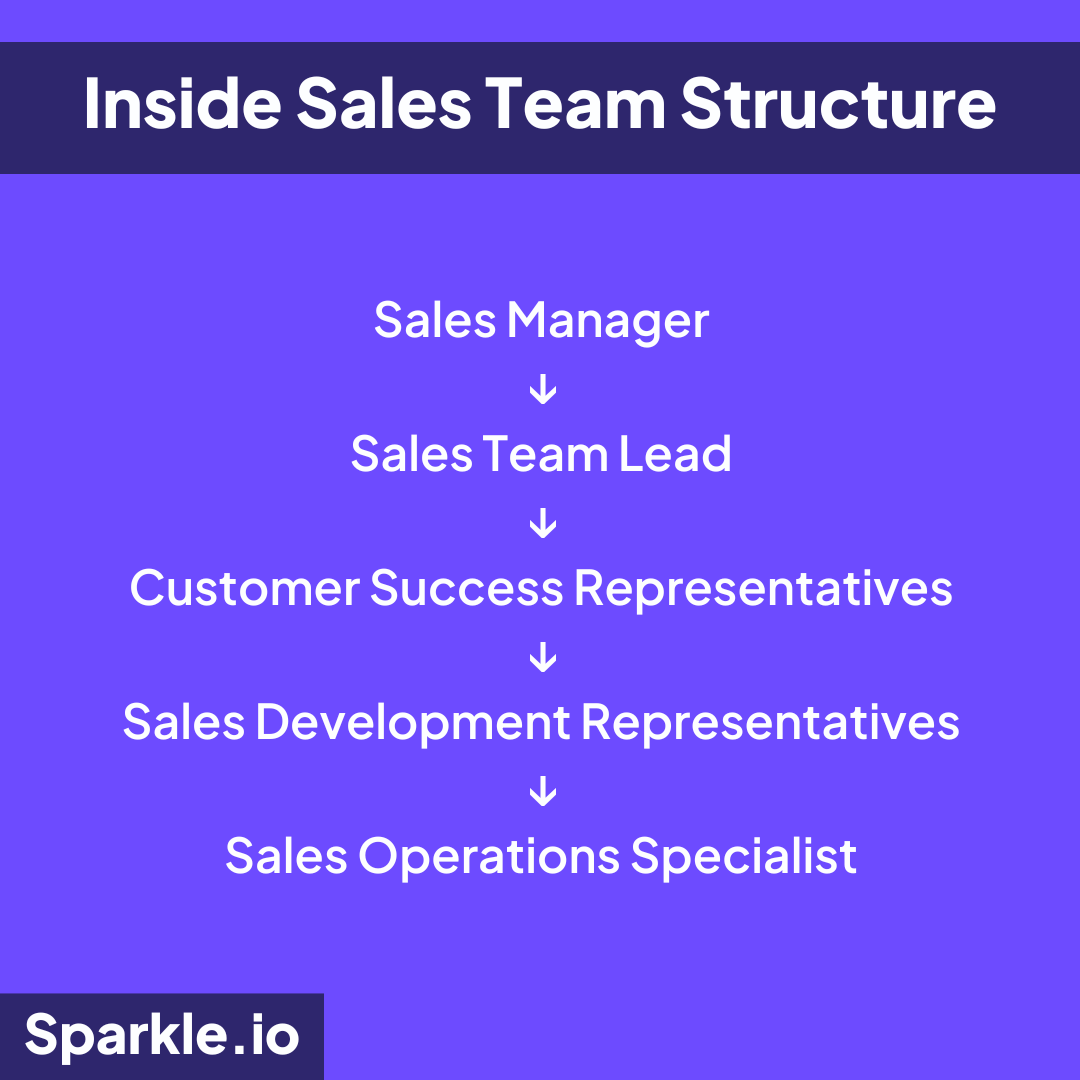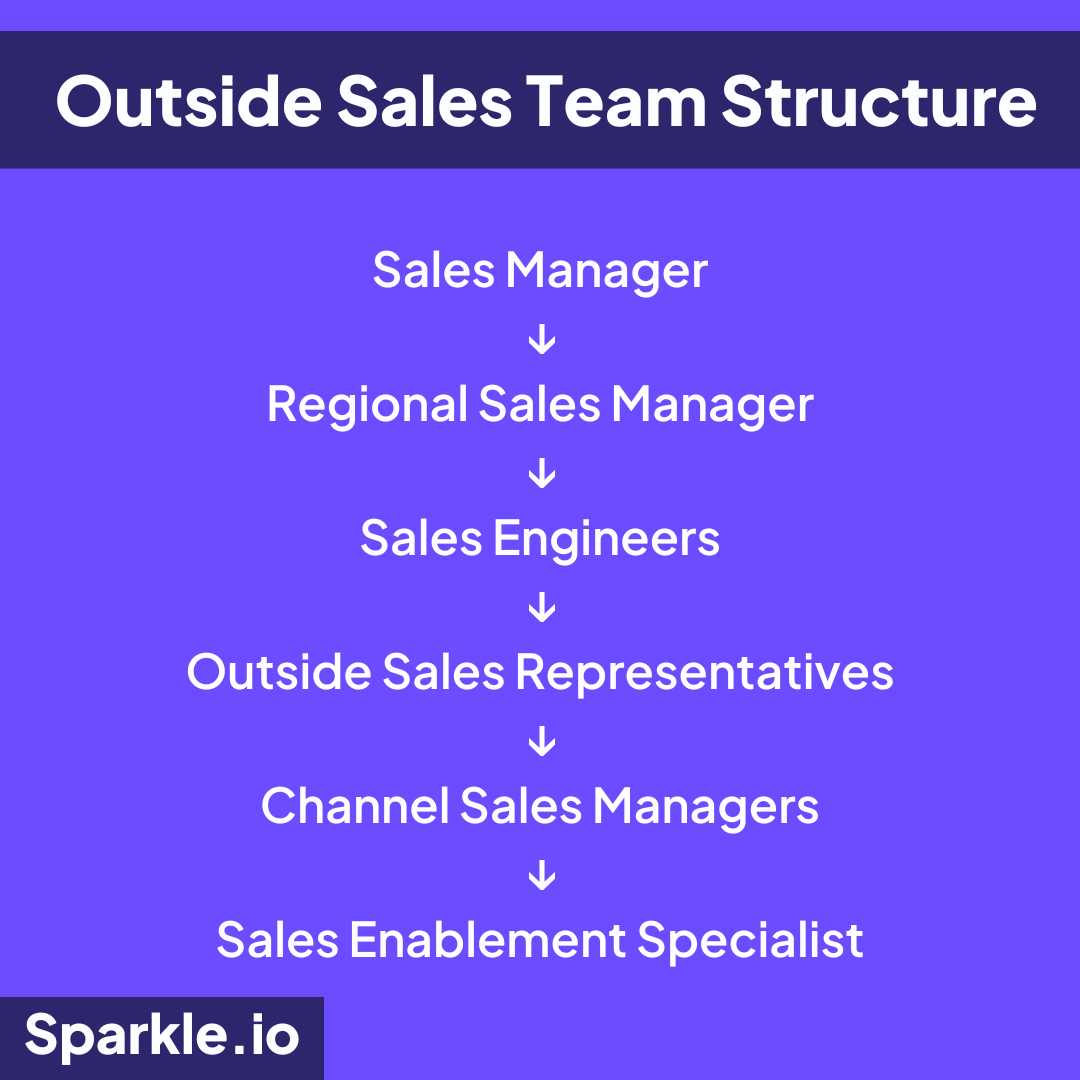
Want to build a high-performing sales team?
But, debating between inside vs outside sales?
Hold on! Let me break it for you.
Key Takeaways
- Inside sales refers to the process of selling products or services remotely, without face-to-face interactions, utilizing tools such as phones, emails, and virtual meetings.
- Outside sales involves direct, in-person selling where sales representatives travel to meet clients, attend events, and build personal connections.
- Differences between inside and outside sales:
A. Inside sales focuses on efficiency and cost-effectiveness, with shorter sales cycles and lower-priced products.
B. Outside sales allow for stronger personal relationships and higher close rates, but with longer sales cycles and higher-priced complex products.
Table of Contents
What Is Inside Sales?
| Inside sales is a dynamic process of selling without meeting face-to-face. It is achieved using phones, emails, virtual meetings, etc. |
It is often addressed as remote or virtual sales and has become a popular and effective approach in today’s digital world. With the growing trend of remote work, it is transforming the way businesses reach and engage with customers.
What Is Outside Sales?
| Outside sales involve direct face-to-face selling. It requires travel to meet clients, attend events, and build personal connections. |
This methodology allows sales representatives to build stronger relationships with potential clients by providing a more personalized experience. Also allowing them to tailor their pitch and solutions accordingly.
Inside vs Outside Sales Team Structure
There is this quote I really love, and it’s from someone I really admire, Steve Jobs. I often wish he were still around to tackle more of the world’s problems. He once said, “If you really look closely, most overnight successes took a long time.” Isn’t that so true?

Putting together a sales team is no simple task. Finding the right folks is a real challenge, and figuring out where they fit best, whether inside the office or out there in the field, is no walk in the park either.
That’s why having a well-structured team is absolutely crucial. Setting realistic goals and defining them clearly is the secret sauce for business growth.
Within the inside sales team, the Sales managers set revenue targets and manage budgets for profitability. Team leads oversee pipelines and conduct performance reviews for success. Account Executives handle discovery calls and client relationships, while Sales Development Representatives qualify leads, schedule appointments, and refine outreach strategies. Sales Operations Specialists implement processes and generate sales reports.

When it comes to outside sales team it is a bit different story, the Outside Sales Manager strategizes field sales, sets revenue targets, and manages budgets. Regional Sales Managers implement strategies, monitor territory pipelines, and collaborate cross-functionally. Sales Engineers provide technical expertise and conduct demos. Outside Sales Representatives identify customers, conduct meetings, and manage sales. Channel Sales Managers handle partners, set targets, and collaborate with marketing. Sales Enablement Specialists deliver training, update sales materials, and analyze sales data.

Responsibilities of Inside vs Outside Sales
Transitioning from the team structures, what next? “Their actions.”
Let me explain to you the responsibilities of the inside and outside sales teams. I’ll give you a quick rundown of who does what, to keep the sales machine running smoothly.
Inside Sales
Have a closer look at the responsibilities that each member of an inside sales team takes on:
| Roles | Responsibilities |
| Sales Manager | – Develops a sales strategy to achieve company goals – Sets revenue targets to meet financial objectives – Manages budget to optimize resources and profitability – Builds and leads sales team to drive business growth |
| Sales Team Lead | – Implements sales strategy to align the team with company goals – Monitors pipeline to identify opportunities and risks – Conducts performance reviews to ensure the team’s contribution to company success |
| Customer Success Relationship or Account Executives (AEs) | – Conducts in-depth discovery calls, demonstrates, and closes deals – Manages account relationships, expansions, and renewals – Partners with customer success to boost client satisfaction and growth |
| Sales Development Representatives (SDRs) | – Qualifies leads by assessing their fit with the ideal customer profile during initial discovery calls – Schedules qualified appointments and demos for Account Executives – Collaborates with marketing to refine outreach strategies |
| Sales Operations Specialist | – Configures and manages CRM system for optimal performance – Designs and implements efficient sales processes and policies – Generates reports and analyzes data to track sales metrics |
Outside Sales
Now, let’s shift our focus to the outside sales team and explore the key responsibilities of each role.
| Roles | Responsibilities |
| Sales Manager | – Develops and executes field sales strategy – Sets revenue targets and quotas per territory – Manages budget and resources for field sales – Builds and leads outside sales team |
| Regional Sales Managers | – Implements regional sales strategies, sets quotas, allocates resources – Coaches and mentors outside sales reps – Monitors regional pipeline, identifies trends and opportunities – Collaborates cross-functionally to address customer needs |
| Sales Engineers | – Provides technical expertise on products – Conducts product demonstrations and presentations – Collaborates with product development for customer requirements – Assists in technical proposals and Request for Proposals (RFPs) |
| Outside Sales Representatives | – Identifies and qualifies potential customers in assigned territory – Conducts face-to-face meetings and presentations – Manages sales process from initial contact to closing – Maintains and expands relationships with existing customers |
| Channel Sales Manager | – Develops and manages channel partner relationships – Sets sales targets and incentives for channel partners – Provides training and support to channel partners – Collaborates with marketing for joint promotions and campaigns |
| Sales Enablement Specialist | – Delivers training programs to upgrade team skills – Creates and updates sales materials – Analyzes sales data and provides insights – Collaborates with marketing and product teams for messaging |
Skills Required For Inside and Outside Sales
You know what, when I started Sparkle.io, I didn’t focus on hiring top executives or managers right away. Instead, I concentrated on building a solid foundation. Often I believe that with a solid foundation, you can kick things off and set the tone for the entire sales process.
The essential skills I look for while hiring for sales roles:
Active Listening
Active listening is crucial for professionals to understand the customer’s needs, concerns, and objections. It helps them tailor their approach and provide appropriate solutions.
Problem-Solving
Must possess problem-solving skills to recognize the challenges that potential customers encounter. They should be able to provide suitable solutions that meet the customers’ needs.
Relationship building
Cultivating connections with clients is essential for sustained success. Possessing strong interpersonal skills and the ability to establish trust and rapport with clients is the key.
Time Management
Being skilled at managing time is essential for prioritizing tasks, meeting deadlines, and enhancing productivity.
Research
Having research skills is crucial for staying updated on industry trends, competitor offerings, and customer preferences. This knowledge helps them position their products or services effectively.
Technology Proficiency
Apart from this, having knowledge of advancing technologies is not a required skill but if present would be a credit for the hirers.
For inside sales, familiarity with CRM, communication tools, and sales platforms boosts productivity. For outside sales, leveraging sales tools, presentation tech, and mobile devices enables seamless on-the-go work.
Budget Planning
Once I have identified the skills required for my sales team and started the hiring process, the next crucial aspect I consider is compensation. Having a good budget is important for any company. It makes sure that the money is spent wisely to hire and keep the best workers.
I work closely with my HR and finance departments to understand the market rates for various roles within the sales department. This teamwork enables me to propose salary packages that can bring in and keep top-notch employees.
When I’m supposed to create the budget for my company, I rely on information from sources such as Glassdoor. As of now, according to Glassdoor, inside sales reps earn an average of $113K annually, while outside sales reps earn an average of $193K.
This data allows me to assess how our compensation packages measure up against industry norms and keep us competitive, in the market.
Along with referring data, I collaborate with my HR and finance teams to maintain the budget and provide fair compensation that reflects our company values. It’s vital to recognize our sales team’s hard work, as they drive our success.
To motivate them, we’ve implemented the “On-Target Earnings” (OTE) system, combining base salary with performance-based commissions. This gives our sales reps a clear understanding of their earning potential and motivates them to go above and beyond their targets.
Impact of Inside and Outside Sales on a Business
Inside and outside sales play a crucial role in a business’s success. Let’s explore the impacts to find which suits your business the best.
Cost-effectiveness
Inside Sales – Reduces travel expenses by conducting sales remotely through virtual meetings, instant messaging, social media, or AI-powered chatbots.
Outside Sales – Higher travel and accommodation costs, but the potential for securing contracts and building lasting relationships may justify these expenses.
According to a study, inside sales seem much better as its call costs approximately $50 when compared to outside sales call which costs around $308.
Improved customer engagement
Inside Sales – Engages a large customer base consistently through multichannel online platforms, regardless of location.
Outside Sales – Builds strong, personal relationships through face-to-face interactions, fostering trust and loyalty that drives sales and business prosperity.
Outside sales reps achieved an impressive 40% close rate on average, surpassing inside sales.
Scalability
Inside Sales – Leverages advanced technologies like AI-powered analytics, automation, and immersive virtual environments to scale sales efforts easily without significant infrastructure changes.
Outside Sales – Scalability is limited by the size and efficiency of the field sales team.
Sales Cycle
Inside Sales – Quickly engages with a large number of prospects through digital channels, shortening the sales cycle from lead qualification to deal closure.
Outside Sales – Experiences longer sales cycles due to the time invested in real-time interactions and the involvement of multiple stakeholders in decision-making.
To sum it up,
| Parameter | Inside Sales | Outside Sales |
| Cost-effectiveness | Reduces costs | Increases in costs due to travel expenses |
| Improved Customer Engagement | Anytime, anywhere, but less personal | Considers client’s free time, builds stronger relationships |
| Scalability | Easily scalable | Limited scalability |
| Sales Cycle | Shorter sales cycle | Longer sales cycle |
Inside vs Outside Sales Team: Models
When it comes to structuring sales teams, you have two main models to choose from inside and outside sales.
Have a look at the most common BAUs (Business As Usual) that take place in each sale, to understand the key components and activities involved in each of these models:
Inside Sales Team Model
- Lead generation: Find potential customers through various channels.
- Qualification: Evaluate leads to determine fit and purchase likelihood.
- Outreach: Contact qualified leads to introduce the offering and assess interest.
- Product demonstration: Showcase features and benefits through online demos or webinars.
- Objection handling: Address concerns and provide solutions to overcome purchase barriers.
- Closing: Guide prospects through the purchase process, from negotiation to contract signing.
- Follow-up: Maintain customer contact post-sale for satisfaction, support, and additional sales.
Outside Sales Team Model
- Territory management: Assign reps to specific areas or segments for optimal coverage.
- Prospecting: Find potential customers via events, networks, and target account research.
- Appointment setting: Contact prospects to schedule face-to-face meetings.
- Product demonstration: Showcase the offering’s features and benefits in person.
- Relationship building: Develop trust with prospects through attentive, personalized interactions.
- Objection handling: Address concerns during meetings to overcome purchase barriers.
- Closing: Guide prospects through negotiation, quoting, and contract signing.
- Follow-up: Maintain customer contact post-sale for satisfaction, support, and growth.
FAQs
1. What is an example of inside sales?
An example of inside sales is a software company representative selling products to businesses through remote communication channels such as telephone calls, email correspondence, and virtual meeting platforms.
2. Is inside sales the future?
While inside sales have been growing rapidly due to advancements in technology and changes in buyer behavior, both inside and outside sales will likely continue to play important roles in the future.
3. What is better, inside or outside sales?
The choice between inside and outside sales depends on factors such as the product, target market, and company goals. Both approaches have their strengths and can be effective when used in the right context.
4. Are outside sales door-to-door?
Outside sales can include door-to-door sales, but it also encompasses other face-to-face selling methods such as scheduled meetings, trade shows, and client visits.
5. What do outside sales reps wear?
Outside sales reps typically dress professionally, wearing business attire such as suits or business casual clothing, depending on the industry and company culture.
Find Your Sales Fit
To sum it up, I’ve found that outside sales tactics thrive in sectors that prioritize in-person connections and fostering relationships, such as high-end B2B transactions or intricate solution-based sales.
Conversely, inside sales strategies have worked best for me when dealing with software-as-a-service (SaaS) or e-commerce products. It’s a cost-effective and scalable approach as it relies on virtual interactions.
But in my experience, the most effective strategies combine inside and outside sales, with inside reps generating leads and outside reps closing deals. I choose the approach that best fits my business, and I always remember to:
- Play to the strengths of each sales method
- Build a team with the right mix of skills
- Encourage collaboration between my inside and outside sales teams
Now I’m ready to go out there and crush my sales goals! With the right strategy and a dedicated team by my side, I believe there’s no limit to what I can achieve.
References:
8 sales team structure models – plus scenarios to build them out, Resources For Employers
AI for Sales: What You Need to Know, Marketing Artificial Intelligence Institute